To perform at their best in the Paris 2024 Olympics, athletes need quality rest, but some are finding it hard to come by. The infamous cardboard beds in the Olympic Village, initially introduced for their sustainability, have become a topic of widespread discussion and concern among the athletes.

Cardboard Beds: An Uncomfortable Reality
The cardboard beds, first seen in the Tokyo 2020 Olympics, were designed to be sturdy and sustainable. However, many athletes have found them to be uncomfortably firm. Australian water polo player Tilly Kearns shared her experience on TikTok, describing her bed as “rock solid” and expressing disappointment despite flipping the mattress to its “softer” side. Her video, which received over 1.1 million likes, highlighted the struggle many athletes face. “My back is about to fall off,” her roommate added, underscoring the discomfort.
These beds, produced by Airweave, feature mattresses made of AirFiber with three customizable sections for firmness. Despite these options, athletes like gymnast Simone Biles have expressed dissatisfaction, labeling the beds as subpar in the comments on social media. The addition of mattress toppers has been a suggested remedy, but it remains to be seen if they will significantly improve the situation.
The Importance of Sleep for Athletes
Dr. Carlos M. Nunez, a sleep expert and chief medical officer at ResMed, emphasized the critical role of sleep in an athlete’s performance. He pointed out that sleep, alongside diet and exercise, forms the foundational pillars of health. For Olympic athletes, who depend on optimal recovery to perform at their peak, any sleep disruption can be detrimental.
Nunez explained that adjusting to a new mattress can take time and may initially cause discomfort and poor sleep quality. “Anytime you change firmness, up, down, or whatever, there can be an adjustment period that could lead to things like little backaches and aches and pains,” he noted. This adjustment period can be particularly challenging for athletes who need to maintain top physical condition.
Heat Adds to Sleeping Challenges
In addition to the bed issues, athletes are also facing the challenge of heat. The Paris games are predicted to be among the hottest in Olympic history, yet the Olympic Village does not provide air conditioning. This lack of cooling exacerbates sleep problems, as optimal sleep environments are typically cool, ideally below 70 degrees Fahrenheit.
Team USA, along with athletes from the UK, Australia, Denmark, and Italy, are bringing their air conditioning units to combat the heat. However, these portable units introduce another issue: noise. Nunez explained that while a cool environment is crucial for sleep, the noise from portable AC units might disrupt rest. Solutions like earplugs are suggested to mitigate this issue.

The combination of firm cardboard beds and the absence of air conditioning presents significant obstacles for athletes trying to achieve restful sleep in the Olympic Village. As they navigate these challenges, the importance of adequate rest for their overall performance and well-being remains a pressing concern.
